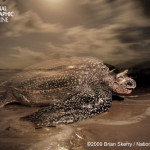
Lophelia pertusa is a framework building scleractinian coral found between 200 – 1000m in the Gulf of Mexico and around the world. Suspension feeding galatheoid crabs are typically associated with Lophelia thickets and bioherms. Their chelipeds are outstretched to capture particulate organic matter from the water column. Notice the marine snow ‘falling’ in the background. The coral framework provides habitat to numerous associated species of fish and invertebrates. Special thanks to Dr. Ian MacDonald from TAMU-CC for contributing the picture.
Tune in for Coral Week April 27- May 3 at Deep Sea News. Craig made a special banner for the event that reminds him of his last mai-tai and posted it at the top of the page. Can you see it? His banners just keep getting better and better, don’t ya think?






upon what does this stuff anchor? I thought the bottom of the gulf is all silt, and difficult for sessile orgs to establish.
There are carbonate rocks down there too. It can be formed as a byproduct of coupled reaction where microbes in the sediment reduce of sulfate, while another set oxidizes methane. The summary reaction is:
CH4 + SO4(2-) -> HCO3(-) + HS(-) + H2O
Me thinks I need to post on this during coral week!
The bottom is not all silt. Northwest Gulf of Mexico banks and mounds are good habitat. They number in the hundreds. They are formed, in part, by salt tectonism. Kevin’s right that authogenic carbonates by microbial action also create good settlement substrate for deep corals. But remember still, not all corals require hard substrate to settle.
Ooooh, Lophelia!
I’m having a lot of fun reviewing video from a sea mount expedition right now. Trying to put together a brief deep sea fishing effects DVD. I love all the associates that can be found with them!